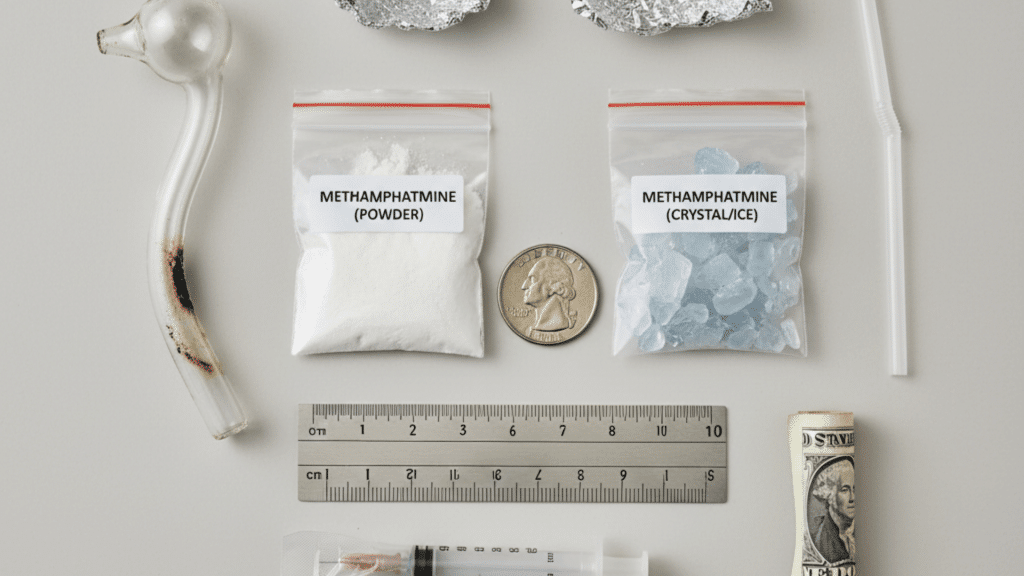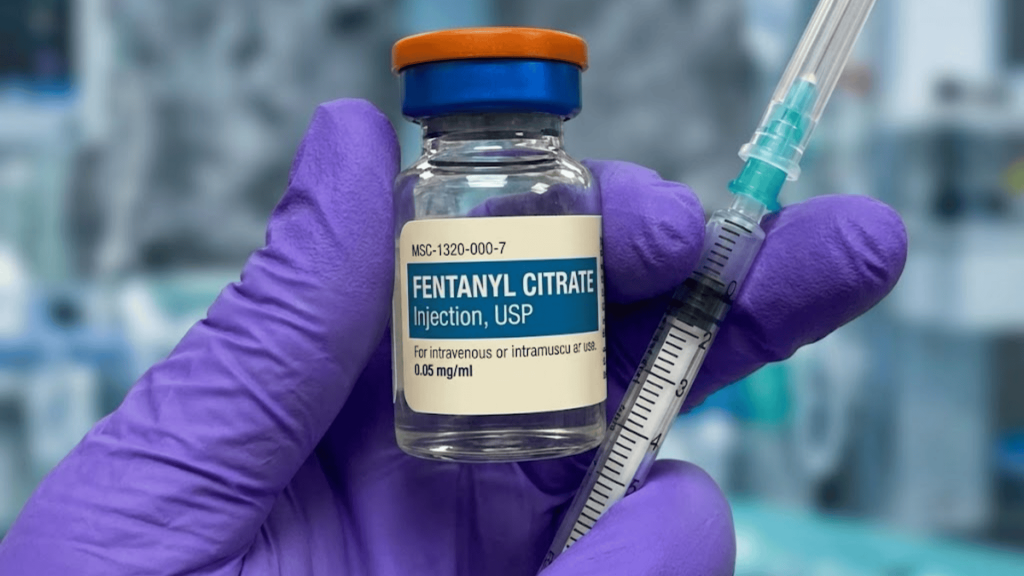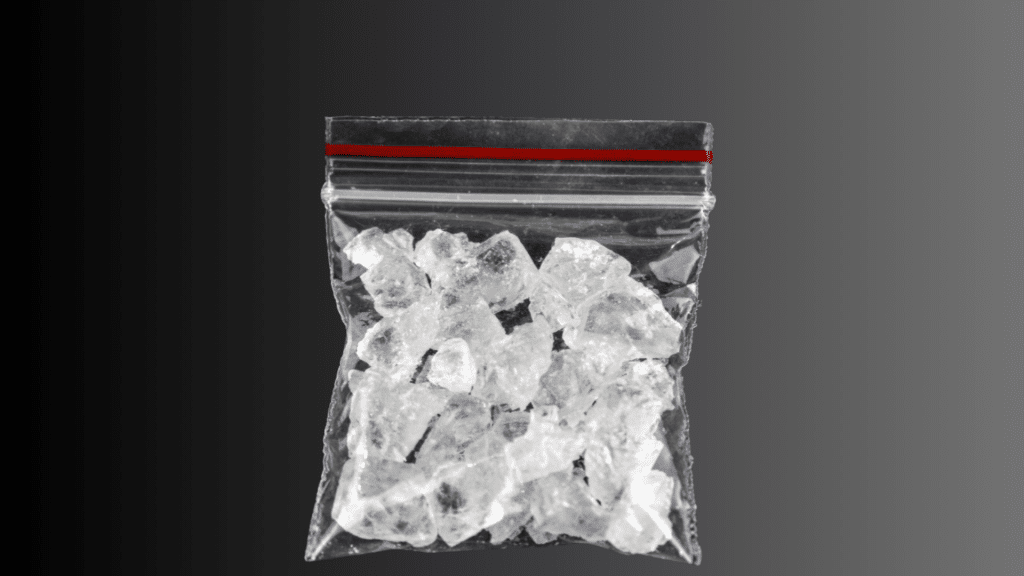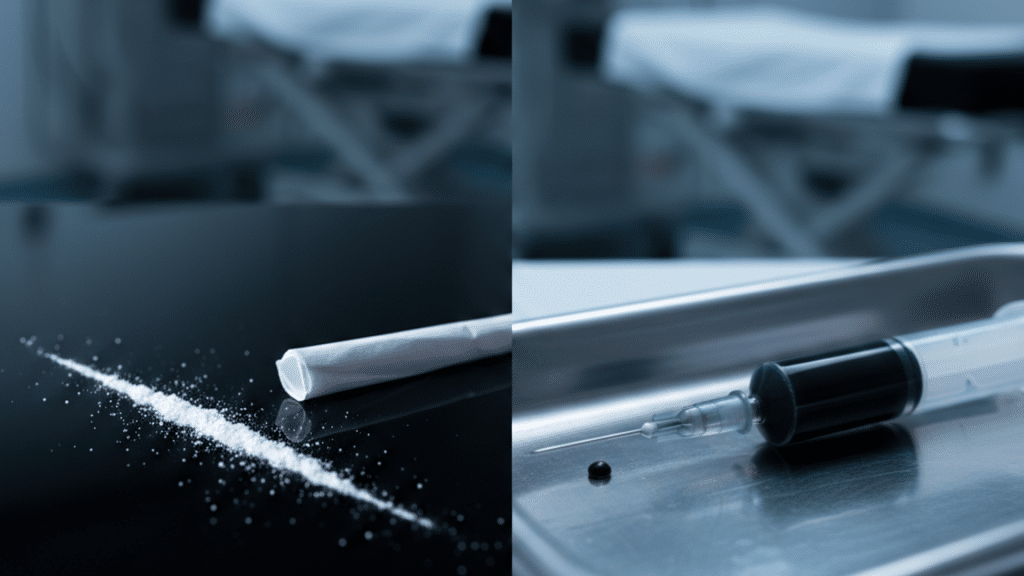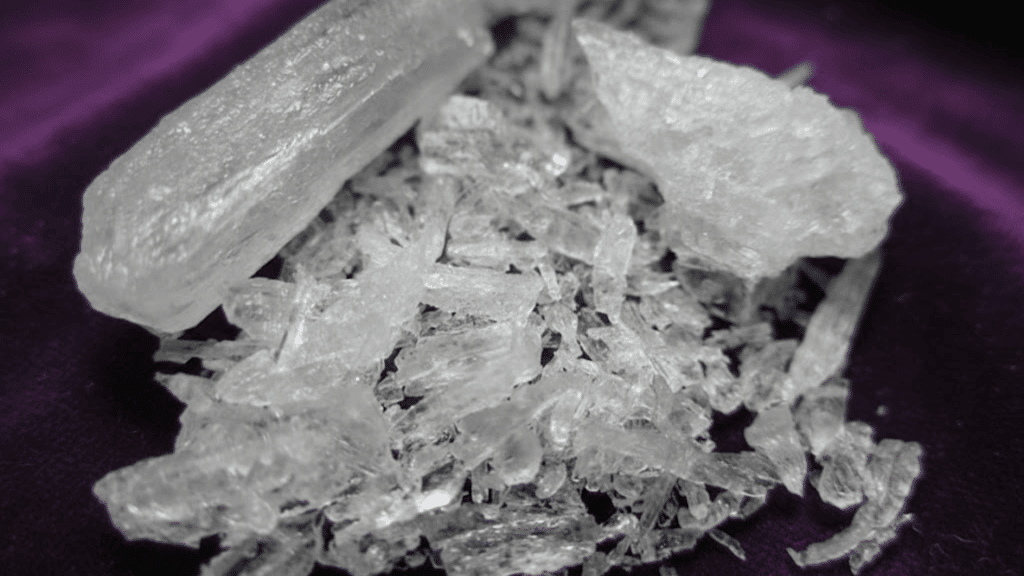Methamphetamine, or meth, creates a powerful surge of energy and confidence that can feel almost unstoppable.
When I first learned about it, I was struck by how intensely it stimulates the mind and body, but that quick rush comes with a shadow: feelings of anxiety, paranoia, and serious physical dangers can follow.
The effects don’t just stop after one use; over time, meth can cause alarming damage to the brain, heart, and even teeth, damaging health in ways that are hard to reverse.
In this blog, we’ll look into how meth affects the body and mind, the signs of addiction, and the serious health risks involved, helping you understand why this drug is so harmful and what to watch out for.
What Meth is?
Methamphetamine is a powerful synthetic stimulant that affects the central nervous system, creating intense feelings of euphoria, increased energy, and alertness.
It appears mainly in two forms: a white or off-white powder and a crystalline solid known as crystal meth, ice, or Tina, which looks like shiny, bluish-white rocks. Methamphetamine is highly addictive and dangerous.
People use it in several ways, including smoking, which provides a rapid and intense high, snorting the powder, injecting directly into the bloodstream, or swallowing it.
The method of use influences how fast and strong the drug’s effects are, with smoking and injecting producing the quickest and most intense highs. This drug poses serious health risks, especially with repeated use.
Meth Consumption: Short-Term Effects

Methamphetamine produces an intense but short-lived surge of energy and euphoria that many find stimulating and addictive.
While users often feel more alert and confident initially, these effects can quickly give way to negative psychological and physical reactions.
1. Typical Sensations
Methamphetamine typically produces a powerful surge of increased energy, alertness, and euphoria. Users often feel intensely confident and talkative, with faster speech and a noticeable reduction in appetite.
These effects can create a strong sense of well-being and heightened focus, making users feel invincible or highly productive.
The initial rush is very intense but fades quickly, sometimes leading to repeated use to maintain the high. This rapid onset of stimulating sensation is a key reason why methamphetamine is highly addictive.
Immediate Symptom: Increased energy and euphoria
2. Psychological Effects
The psychological effects of meth include heightened anxiety, irritability, and restlessness. Users may experience mood swings, increased sexual drive, and sometimes paranoia.
Meth can sharpen thinking temporarily, but it also risks triggering severe psychological distress, such as paranoia or aggressive behavior.
These effects can escalate rapidly, interfering with normal social and emotional functioning and increasing the risk of erratic or violent actions.
Immediate Symptom: Anxiety and irritability
3. Physical Effects
Methamphetamine causes significant physical changes such as increased heart rate, elevated blood pressure, and rapid or irregular breathing.
Sweating and dilated pupils are common, along with elevated body temperature. These effects place considerable stress on the cardiovascular system.
This can contribute to dangerous health complications like stroke or heart attack, especially during high doses or frequent use.
Immediate Symptom: Increased heart rate and high blood pressure
Meth Consumption: Longer-Term, or Chronic Effects

Long-term methamphetamine use causes serious damage to multiple body systems over weeks, months, and years.
These chronic effects can deteriorate brain function, harm the heart, and cause visible physical damage, along with social and infectious risks that worsen overall health.
4. Brain and Mental Health
Long-term methamphetamine use causes significant changes in brain function, leading to memory loss, impaired cognition, and emotional disturbances.
Users may develop mood disorders such as depression and anxiety, along with psychotic symptoms like paranoia, hallucinations, and delusions.
These effects can persist for months or years after quitting and may significantly impair daily functioning. Some brain changes may be partially reversible with time and abstinence, but mental health recovery can be slow and challenging.
Seek Pro Guidance If: Experiencing persistent memory problems, mood swings, hallucinations, or ongoing paranoia.
5. Cardiovascular Risks
Chronic meth use severely strains the heart and blood vessels, increasing the risk of high blood pressure, irregular heartbeat, and heart attacks.
Long-term misuse can cause permanent damage to the cardiovascular system, raising the chance of stroke and heart failure.
Even young users face these risks due to meth’s vasoconstrictive properties that reduce blood flow, which can have life-threatening consequences.
Seek Pro Guidance If: Experiencing chest pain, irregular heartbeats, dizziness, or stroke symptoms.
6. Oral and Skin Effects
Methamphetamine use often leads to “meth mouth,” characterized by severe tooth decay, gum disease, and tooth loss. This results from dry mouth, poor oral hygiene, and teeth grinding.
Skin issues include sores and infections caused by compulsive picking due to sensations of bugs crawling under the skin.
These visible effects can cause significant pain, infection risks, and embarrassment.
Seek Pro Guidance If: Notice rapid dental decay, persistent oral pain, or skin sores that do not heal.
7. Infectious Disease & Social Harms
Injecting meth increases the risk of contracting HIV, hepatitis B, and C through shared needles.
Chronic use disrupts social and occupational functioning, often leading to job loss, strained relationships, and isolation.
These social harms compound health risks and make recovery more challenging. Addressing both infection risks and social factors is critical in treatment.
Seek Pro Guidance If: Experiencing social withdrawal, job difficulties, or signs of infection like fever or sores.
The Comedown and Withdrawal
The methamphetamine comedown, often called a crash, happens as the drug’s intense high fades, leaving individuals feeling extremely tired and emotionally down.
This phase can bring intense cravings for more meth, making it difficult to resist using again. Many people experience deep depression and struggle with sleep problems, ranging from insomnia to excessive sleepiness.
The body’s stimulant overload shuts down, causing a mental and physical slump as it tries to recover.
These crash symptoms are uncomfortable and can last from hours to days, depending on the extent of meth use and individual factors.
Methamphetamine Overdose: Signs and What to Do

Methamphetamine overdose is a medical emergency requiring immediate attention. Recognizing the key warning signs can save a life, and knowing how to respond while waiting for professional help is crucial for safety.
Red Flags
Recognizing meth overdose signs early is vital. Look for:
- Extreme agitation or violent behavior
- Chest pain or tightness
- Difficulty breathing or shortness of breath
- Very high fever or overheating
- Seizures or sudden loss of consciousness
These symptoms indicate a life-threatening situation needing urgent medical care. Prompt action can prevent serious complications or death.
Immediate Response
If overdose is suspected, call emergency services without delay. Keep the person calm and safe, removing any sharp or dangerous objects nearby.
If they’re unconscious but breathing, place them in the recovery position to maintain an open airway.
Monitor their breathing and pulse closely, and provide first aid if trained, especially for seizures or stopped breathing, until help arrives. Never leave them alone.
Why Meth is Addictive?
Methamphetamine causes a massive surge of dopamine in the brain’s reward circuit, producing intense pleasure. This overstimulation leads to changes in brain pathways and structure, reinforcing drug-seeking behavior.
Over time, the brain adjusts by requiring higher doses to achieve the same effects, a process called tolerance. This drives compulsive use despite harmful results.
The brain’s natural ability to feel pleasure diminishes, making recovery challenging.
These insights come from the “Methamphetamine” report by the National Institute on Drug Abuse (NIDA), which details how biological changes underpin addiction and complicate treatment efforts, NIDA Research Report Series.
Signs Someone is Using Meth
Methamphetamine use can show up through various behavioral, physical, and environmental signs. Recognizing these patterns early helps provide support and intervention.
| Type | Common Signs & Cues | Examples/Details | Potential Impact |
|---|---|---|---|
| Behavioral | Sleep loss or insomnia | Staying awake for days, erratic sleeping | Fatigue, impaired judgment |
| Secrecy & isolation | Avoiding friends/family, secretive calls | Social withdrawal, trust issues | |
| Mood changes | Irritability, aggression, hyperactivity | Conflict with others, unpredictable behavior | |
| Physical | Rapid weight loss | Noticeable thinness or gaunt appearance | Malnutrition, weakened immune system |
| Dilated pupils & dry mouth | Enlarged pupils, constant thirst | Vision issues, discomfort | |
| “Meth mouth” | Cavity-ridden teeth, gum disease | Pain, tooth loss, infection risks | |
| Skin problems | Sores, scabs, picking marks | Infection, scarring | |
| Environmental | Drug paraphernalia | Pipes, needles, foil, small bags | Risk of infection, legal issues |
| Financial difficulties | Unexplained spending or borrowing money | Economic instability |
If signs worsen rapidly, or involve violent behavior, unconsciousness, or breathing difficulties, call emergency services immediately for professional assistance.
Methamphetamine Treatment Options & Harm Reduction

Methamphetamine addiction is complex but treatable. Behavioral therapies form the foundation of treatment by addressing the psychological and behavioral aspects that sustain drug use.
In addition, harm reduction strategies help minimize adverse health outcomes for users not yet ready to quit entirely. Accessible support services provide crucial resources and referrals to guide individuals on the path to recovery.
1. Behavioral Therapies and Support
Behavioral therapies are the cornerstone of methamphetamine use disorder treatment. Contingency management, a leading approach, offers tangible rewards like cash or vouchers for maintaining sobriety, helping motivate users to stay drug-free.
Counseling therapies such as cognitive-behavioral therapy (CBT) teach coping strategies to identify triggers, manage cravings, and avoid relapse.
Group support and motivational interviewing also play a vital role. While no FDA-approved medications yet exist specifically for meth addiction, ongoing research aims to find effective pharmacological treatments, National Institute on Drug Abuse.
2. Practical Harm-Reduction Steps
Harm reduction involves practical strategies to reduce the risks associated with methamphetamine use, focusing on safety and health, even if quitting is not immediate.
- Never use meth alone; having trusted company reduces the risk of overdose.
- Always use clean needles and other supplies to prevent infections like HIV and hepatitis.
- Carry naloxone to reverse opioid overdoses, as fentanyl contamination in meth is common.
- Seek immediate medical attention if overdose symptoms occur.
- Stay hydrated and maintain good nutrition to support overall health.
These steps help lower the dangers of meth use while supporting safer practices and eventual recovery
3. Where to Find Help?
Support for meth use disorder is available through multiple channels. The Substance Abuse and Mental Health Services Administration (SAMHSA) offers a national helpline (800-662-HELP) and an online treatment locator.
Local treatment centers provide outpatient and inpatient programs, including counseling and behavioral therapies. Many communities have 12-step programs or SMART Recovery groups specifically for stimulant use.
Confidential professional help combined with community support enhances chances of recovery, SAMHSA.
Methamphetamine Common Myths and Facts
Methamphetamine addiction is clouded by many myths that can prevent awareness and seeking help. Breaking these misconceptions is essential to understanding the risks and realities.
| Myth | Fact |
|---|---|
| Myth 1: Meth is Never Addictive the First Time | Meth is highly addictive, though not everyone becomes addicted after one use. The powerful dopamine surge increases risk rapidly. |
| Myth 2: Meth Addiction is a Choice | Addiction is a chronic brain disorder caused by changes in brain chemistry, not a voluntary decision. |
| Myth 3: It’s Impossible to Recover from Meth Addiction | Recovery is achievable with effective behavioral therapies, counseling, and support systems. |
| Myth 4: Some Types of Meth are Safer | All forms of methamphetamine are addictive and dangerous, regardless of purity or form. |
Resources & References
Access to credible resources is critical for anyone affected by methamphetamine use. The National Institute on Drug Abuse (NIDA) offers comprehensive scientific research and treatment information.
The Centers for Disease Control and Prevention (CDC) provides vital public health data on overdose prevention and safety. The Substance Abuse and Mental Health Services Administration (SAMHSA) operates a 24/7 national helpline and treatment locator to connect individuals with local support.
Additionally, local crisis lines offer immediate assistance tailored to each region.
These authoritative organizations provide evidence-based guidance, treatment options, and emergency support to help individuals and families navigate meth use disorders effectively.
Wrapping It Up
I’ve witnessed how methamphetamine addiction can rapidly take hold, tearing apart lives and draining hope. Yet, I am encouraged by stories of real people who have fought back and reclaimed their futures.
Recovery is challenging and often non-linear, but it is possible with perseverance, support, and the right treatment.
Learning about effective therapies and harm reduction strategies has strengthened my belief that no one is beyond help.
If this blog has offered insight or hope, I invite readers to share their thoughts or their own experiences in the comments. Together, we can break stigma and support those seeking a healthier path forward.

